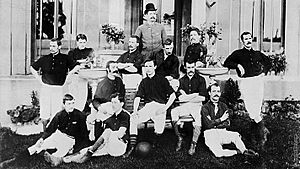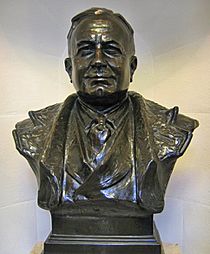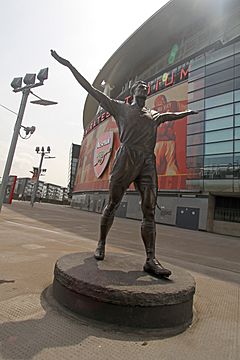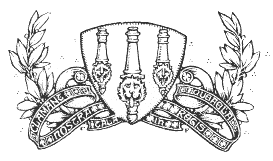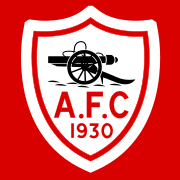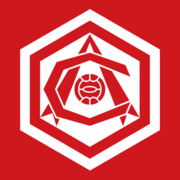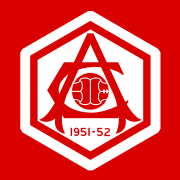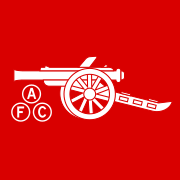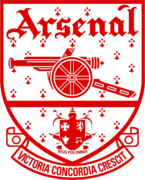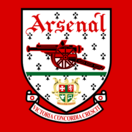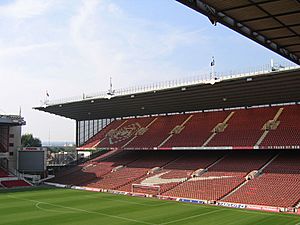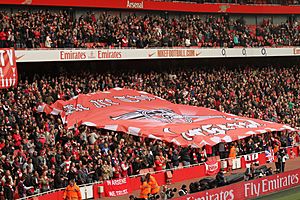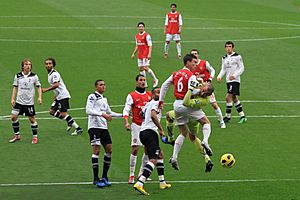Arsenal F.C. facts for kids
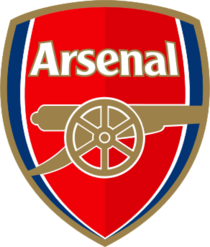 |
||
| Full name | The Arsenal Football Club | |
|---|---|---|
| Nickname(s) | The Gunners Gooners (supporters) |
|
| Founded | 11 December 1886, as Dial Square | |
| Ground | Emirates Stadium | |
| Capacity | 60,704 | |
| Coordinates | 51°33′18.3″N 0°06′30.3″W / 51.555083°N 0.108417°W | |
| Owner | Kroenke Sports & Entertainment | |
| Co-chairmen |
|
|
| Manager | Mikel Arteta | |
| League | Premier League | |
|
|
||
The Arsenal Football Club, often called Arsenal, is a professional football team. They are based in Islington, North London, England. Arsenal plays in the Premier League, which is the top football league in England.
Arsenal has won many trophies. They have 13 league titles, including one where they didn't lose a single game! They also hold a record 14 FA Cups, 2 League Cups, and 17 FA Community Shields. In European competitions, they have won one European Cup Winners' Cup and one Inter-Cities Fairs Cup. Arsenal is the third-most successful club in English football based on trophies.
Arsenal was the first club from southern England to join the Football League in 1893. They reached the top division in 1904. They have only been relegated once, in 1913. This means they have the longest continuous stay in the top division. They have also won the second-most top-flight matches in English football history.
In the 1930s, Arsenal won five League Championships and two FA Cups. After World War II, they won another FA Cup and two more Championships. In the 1970–71 season, they won their first "Double" (winning both the League and FA Cup). Between 1989 and 2005, they won five more league titles and five FA Cups, including two more Doubles. They ended the 20th century with the highest average league position. From 1998 to 2017, Arsenal played in the UEFA Champions League for 19 seasons in a row, which is an English football record.
The club was founded in 1886 by workers at the Royal Arsenal in Woolwich. It was first called Dial Square. In 1913, the club moved to Arsenal Stadium in Highbury, North London. This move made them close rivals with Tottenham Hotspur, starting the famous North London derby.
Herbert Chapman helped Arsenal win their first major trophies. His ideas led to many more wins in the 1930s. He introduced new tactics like the WM formation, and also brought in floodlights and shirt numbers. He also changed the team's kit to include white sleeves and a brighter red.
Arsène Wenger was Arsenal's longest-serving manager and won the most trophies. He won a record seven FA Cups. His team in 2003–04 went 49 league games unbeaten, earning them the nickname "The Invincibles". This is an English record for the longest top-flight unbeaten run.
In 2006, Arsenal moved to the Emirates Stadium. Forbes magazine estimated Arsenal to be worth US$2.26 billion, making it the world's tenth-most valuable football club. Arsenal is also one of the most followed clubs on social media. The club's motto is Victoria Concordia Crescit, which is Latin for "Victory Through Harmony".
Club History: From Dial Square to Today
Early Years: 1886–1912
In October 1886, David Danskin and fifteen other workers from the Royal Arsenal in Woolwich started a football club. They named it Dial Square Football Club. Each person put in a small amount of money to help start the club.
Dial Square played their first game on December 11, 1886, and won 6–0. By January 1887, the club was renamed Royal Arsenal. They played their early games at Plumstead Common and later at the Manor Ground.
Royal Arsenal won their first trophies in 1889–90, including the Kent Senior Cup. In 1891, they became the first London club to turn professional.
In 1893, Royal Arsenal changed its name again to Woolwich Arsenal. They joined the English Football League in the Second Division. By 1904, they reached the top division, the First Division. However, they faced money problems and almost went bankrupt by 1910.
Moving North: 1912–1925
In 1913, after being relegated, the club moved across London to the new Arsenal Stadium in Highbury. This move helped them get more fans and money. In 1919, The Football League voted to promote Arsenal back to the First Division. This was a bit controversial, as they had only finished fifth in the Second Division.
Later that year, the club officially started dropping "The" from its name. It became known simply as Arsenal, as it is today. With a new home and top-flight football, Arsenal's income grew fast. They became known as the "Bank of England club" because they spent a lot of money on players.
Chapman's Golden Era: 1925–1934
In 1925, Herbert Chapman, a successful manager from Huddersfield Town, joined Arsenal. He built a strong new team. He brought in a new trainer, Tom Whittaker, and helped create the WM formation tactic. Chapman also signed talented young players like Cliff Bastin and Eddie Hapgood, and stars like David Jack and Alex James.
Chapman's Arsenal won their first national trophy, the FA Cup, in 1930. They also won League Championships in 1930–31 and 1932–33. Chapman also made changes off the pitch. He added white sleeves and shirt numbers to the kit. A Tube station was even named after the club! Sadly, Chapman passed away in the middle of the 1933–34 season.
Continuing Success and War: 1934–1947
After Chapman's death, Joe Shaw and George Allison continued his great work. They led Arsenal to three more league titles in 1933–34, 1934–35, and 1937–38. They also won the FA Cup in 1936.
World War II stopped the Football League for seven years. Arsenal was seen as a symbol of national unity during the war. However, the war greatly affected the team, as many players were lost. The club also faced debt from rebuilding parts of their stadium.
Whittaker's Triumphs: 1947–1962
Despite the challenges, Arsenal won the league again in the 1947–48 season. This was Tom Whittaker's first season as manager. This win meant Arsenal equaled the record for most English championships. Whittaker was known as the "brains" behind Chapman's earlier success. He built a strong team even with limited money.
Arsenal won a third FA Cup in 1950. They then won a record-breaking seventh championship in 1952–53. This made Arsenal the most successful team in English history at that time.
A Period of Change: 1962–1984
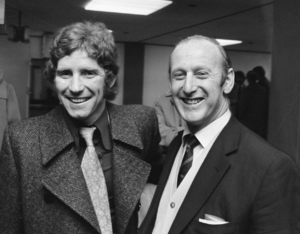
Arsenal did not win the League or FA Cup for 18 years after 1953. The team from 1953 grew older, and the club struggled to find good new players. Arsenal was competitive but spent most of the 1950s and 1960s in the middle of the league table. Even former England captain Billy Wright couldn't bring success as manager from 1962 to 1966.
In 1966, Bertie Mee, the club's physiotherapist, became acting manager. With new assistant Don Howe and players like Bob McNab and George Graham, Mee led Arsenal to their first League Cup finals in 1967–68 and 1968–69.
The next season, Arsenal won their first European trophy, the 1969–70 Inter-Cities Fairs Cup. The season after, in 1970–71, Arsenal achieved an even bigger win. They secured their first League and FA Cup double. This set a new record for English champions. However, the Double-winning team soon broke up. The rest of the decade saw many near misses, with Arsenal finishing as FA Cup runners-up in 1972 and league runners-up in 1972–73.
Former player Terry Neill took over from Mee in 1976. At 34, he was Arsenal's youngest manager. With new players like Malcolm Macdonald and Pat Jennings, and talents like Liam Brady, the club reached three FA Cup finals. They also lost the 1980 European Cup Winners' Cup Final on penalties. Their only trophy during this time was the 1979 FA Cup. They won it with a last-minute 3–2 victory over Manchester United. This final is still remembered as a classic game.
Graham's Defensive Power: 1984–1996
George Graham, one of Mee's Double winners, returned as manager in 1986. Arsenal won their first League Cup in 1987, Graham's first season. New players Nigel Winterburn, Lee Dixon, and Steve Bould joined by 1988. They completed the famous "Back Four" defense, led by homegrown player Tony Adams.
Graham focused on strong defense, which was different from Arsenal's usual attacking style. Many doubted it would work with the young team. However, his methods quickly brought success. The team won the 1988 Football League Centenary Trophy. They followed this with the 1988–89 Football League title. They won it with a last-minute goal in the final game against rivals Liverpool.
Graham's Arsenal won another title in 1990–91, losing only one match. They won the FA Cup and League Cup double in 1993. They also won the European Cup Winners' Cup in 1994. Graham's time ended when he was found to have taken money from an agent for signing players. He was dismissed in 1995. His replacement, Bruce Rioch, only stayed for one season after a disagreement with the club's leaders.
The Wenger Era: 1996–2018
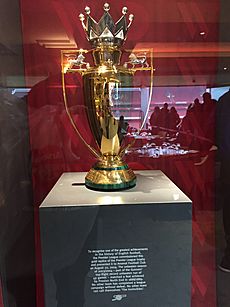
The club changed a lot under French manager Arsène Wenger, who joined in 1996. His time was known for attacking football, better player diets and fitness, and excellent scouting. He brought in key players from his home country, like Patrick Vieira and Thierry Henry.
Arsenal won a second League and Cup double in 1997–98 and a third in 2001–02. They also reached the final of the 1999–2000 UEFA Cup. They won the FA Cup in 2003 and 2005. In 2003–04, they won the Premier League without losing a single match. This amazing achievement earned them the nickname "The Invincibles". This was part of a 49-game unbeaten run in the league, a national record.
Arsenal finished first or second in the league in eight of Wenger's first nine seasons. However, they never won the title two seasons in a row. The club had never gone past the quarter-finals of the UEFA Champions League until 2005–06. That season, they became the first London club to reach the final, but lost 2–1 to Barcelona.
In July 2006, Arsenal moved to the Emirates Stadium, after 93 years at Highbury. Arsenal reached the finals of the 2007 and 2011 League Cups, but lost both. They had not won a trophy since the 2005 FA Cup until 2014. Led by Mesut Özil, Arsenal beat Hull City 3–2 in the 2014 FA Cup Final, coming back from 2–0 down.
A year later, Arsenal won another FA Cup. They became the most successful club in the tournament's history by winning their 13th FA Cup in 2016–17. However, that season Arsenal finished fifth in the league. This was the first time they were outside the top four since before Wenger arrived. In his final season, Arsenal finished sixth and won the FA Community Shield. Wenger left Arsenal on May 13, 2018.
After Wenger: 2018–Present
After Wenger left, Unai Emery became the new head coach on May 23, 2018. He was the club's first 'head coach' and second manager from outside the UK. In Emery's first season, Arsenal finished fifth in the Premier League and were runners-up in the Europa League. On November 29, 2019, Emery was dismissed, and former player Freddie Ljungberg became interim head coach.
On December 20, 2019, Arsenal appointed former club captain Mikel Arteta as the new head coach. Arsenal finished the 2019–20 season in eighth place, their lowest finish since 1994–95. However, they beat Chelsea 2–1 to win a record 14th FA Cup. After that season, Arteta's title changed from head coach to manager.
In April 2021, Arsenal was announced as a founding club of the European Super League. They withdrew two days later due to widespread criticism. Arsenal finished the 2020–21 season in eighth place again. This meant they did not qualify for a European competition for the first time in 26 years.
The next season (2021–22), Arteta built the youngest team in the Premier League. They finished fifth and qualified for the UEFA Europa League. In the 2022–23 season, Arsenal returned to the Champions League by finishing second to Manchester City. They set a record for most time spent at the top of the league without winning it, ending with 84 points.
In the 2023–24 season, Arsenal beat Manchester City to win their 17th FA Community Shield. They finished second in the Premier League to Manchester City again, with an improved 89 points. In the 2024-25 UEFA Champions League, they reached the semi-finals but lost to PSG 3–1 on aggregate. For the third season in a row, Arsenal finished second in the Premier League, this time behind Liverpool, with 74 points in the 2024–25 season.
Club Crest and What It Means
|
|
Arsenal's first crest, from 1888, showed three cannons. These cannons pointed north, similar to the old coat of arms of Woolwich. People sometimes mistook them for chimneys, but they were clearly cannons. This crest was removed when the club moved to Highbury in 1913.
In 1922, a single cannon was brought back to the crest. It pointed east, with the club's nickname, The Gunners, written next to it. This crest only lasted until 1925, when the cannon was turned to point west.
In 1949, a new, more modern crest was introduced. It had the cannon below the club's name. It also featured the coat of arms of Islington and a scroll with the club's motto, Victoria Concordia Crescit. This Latin phrase means "victory comes from harmony". This was the first time the crest used color, mainly red, gold, and green.
Because the crest changed many times, Arsenal couldn't copyright it easily. To get better legal protection, they introduced a new crest in 2002. This new design had smoother lines and a simpler look. The cannon now faces east again, and the club's name is in a modern font. The color green was replaced by dark blue. Some fans didn't like the new crest, saying it ignored Arsenal's history.
Before the 1960s, a badge was only worn on the playing shirt for important matches, like FA Cup finals. It was usually a monogram of the club's initials (A and C) in red on white. This monogram style was developed into an Art Deco badge in the 1930s. It was used on Cup Final shirts and around Highbury Stadium.
From 1967, a white cannon was regularly worn on the shirts. This was later replaced by the club crest in the 1990s. Sometimes, the nickname "The Gunners" was added.
For their 125th anniversary in the 2011–12 season, Arsenal used a special version of their crest. It was all white, with 15 oak leaves on the right and 15 laurel leaves on the left. The oak leaves represented the 15 founding members of the club. The laurel leaves represented the sixpence coins they paid to start the club, and also strength. The years 1886 and 2011 were shown, along with the motto "Forward".
Starting in the 2021–22 season, Adidas brought back the cannon-only crest for the away kit. This was the first time it had been seen on an Arsenal shirt since 1991. It has continued to be used on away and third kits. In the 2024–25 season, it was used on all three kits.
Team Colors and Kits
|
|
| Arsenal's original home colours. The team wore a similar kit (but with redcurrant socks) during the 2005–06 season. |
|
|
| White sleeves first appeared on the shirt in 1933. |
|
|
| Yellow shirt with blue trim and blue shorts are Arsenal's traditional away colours. |
|
|
| Since the 1990s, Blue has been prominently used for either the away or third kit. |
For most of Arsenal's history, their home kit has been bright red shirts with white sleeves and white shorts. The color red was chosen because Nottingham Forest donated a kit to Arsenal when they started in 1886. Two of Arsenal's founders, Fred Beardsley and Morris Bates, were former Forest players. The original shirt was a dark red, worn with white shorts and socks with blue and white stripes.
In 1933, Herbert Chapman changed the kit to make players stand out more. He added white sleeves and made the red a brighter "pillar box" red. The red-and-white shirts have been Arsenal's signature look ever since. There were only two seasons when they didn't wear this combination. In 1966–67, they wore all-red shirts, which wasn't popular. In 2005–06, they wore dark red shirts to celebrate their last season at Highbury.
Arsenal's home colors have inspired at least three other clubs. Sparta Prague adopted a dark red kit in 1909. Hibernian adopted the white sleeve design in 1938. In 1941, Luis Robledo, an Arsenal fan, chose the main colors for his new team, Santa Fe. In 1920, Sporting Clube de Braga changed their green kit to match Arsenal's red-with-white-sleeves, earning them the nickname Os Arsenalistas. These teams still wear similar designs today.
For many years, Arsenal's away colors were white or navy blue. In 1968, navy shirts were banned because they looked too much like referees' black kits. So, in the 1969–70 season, Arsenal introduced a yellow shirt with blue shorts for away games. This kit became very famous, almost as much as their red-and-white home kit.
Since the 1990s, away kits have changed often. Arsenal usually releases both away and third-choice kits. These designs have been all blue or variations of the traditional yellow and blue.
Kit Sponsors
|
Arsenal's Stadiums
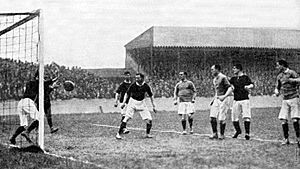
Before joining the Football League, Arsenal played at Plumstead Common and then the Manor Ground. They also spent three years at the nearby Invicta Ground. When they joined the Football League in 1893, they returned to the Manor Ground. They added stands and terraces to make it a proper stadium. Arsenal played their home games there for the next twenty years.
Arsenal Stadium, known as Highbury, was the club's home from 1913 to 2006. The original stadium was designed by Archibald Leitch. It had a common design for the time, with one covered stand and three open terraces. The stadium was greatly updated in the 1930s. New Art Deco stands were built, and a roof was added to the North Bank terrace. This terrace was bombed during World War II and rebuilt in 1954.
Highbury could hold over 60,000 fans at its busiest. Its capacity was 57,000 until the early 1990s. New rules required Arsenal to convert Highbury into an all-seater stadium by 1993–94. This reduced the capacity to 38,419 seats. For Champions League matches, the capacity had to be even lower. So, from 1998 to 2000, Arsenal played Champions League home games at Wembley. Wembley could hold over 70,000 fans.
Expanding Highbury was difficult because of its design and nearby homes. This limited the club's income from match days. In 2000, Arsenal decided to build a new stadium. The new 60,361-capacity stadium, named the Emirates Stadium, is about 500 meters from Highbury. Construction finished in July 2006, ready for the 2006–07 season.
The stadium is named after its sponsor, the airline company Emirates. This was the largest sponsorship deal in English football history at the time. Some fans call the stadium Ashburton Grove or the Grove, as they don't like corporate names. The stadium will be officially known as Emirates Stadium until at least 2028. The airline will also be the club's shirt sponsor until at least 2024. Since the 2010–11 season, the stands are officially called North Bank, East Stand, West Stand, and Clock End. The Emirates Stadium now holds 60,704 people.
Arsenal's players train at the Shenley Training Centre in Hertfordshire. This is a special facility that opened in 1999. Before that, they trained at a nearby site. Until 1961, they trained at Highbury.
Arsenal's Academy under-18 teams play their home matches at Shenley. The reserve team plays at Meadow Park. Both Academy and reserve teams sometimes play big games at the Emirates Stadium.
Fans and Rivalries
Arsenal fans are called "Gooners," which comes from the club's nickname, "The Gunners." Almost all home matches are sold out. In 2007–08, Arsenal had the second-highest average attendance in the English League. As of 2015, they had the third-highest all-time average attendance. Arsenal has the seventh highest average attendance among European football clubs.
Arsenal's location means its fans come from many different backgrounds. The club has many fans outside London and all over the world. In 2007, 24 UK, 37 Irish, and 49 other international fan clubs were connected with Arsenal. A 2011 report estimated Arsenal's global fanbase at 113 million. The club's social media activity was the fifth highest in world football in 2014–15.
Team Songs
The team's anthem is "The Angel (North London Forever)" by Louis Dunford. This song is usually played at Arsenal home games before a match.
Besides common English football chants, Arsenal fans sing "One-Nil to the Arsenal" (to the tune of "Go West"). They also sing "Who's that team they call the Arsenal" and "Good Old Arsenal". Fans also jokingly chant "Boring, Boring Arsenal." This refers to Arsenal's reputation in the 1970s and 1980s for playing a very defensive style.
Main Rivals
Arsenal's oldest and biggest rivalry is with their closest major neighbor, Tottenham Hotspur. Games between them are called the North London derby. There is also a rivalry between Arsenal and Chelsea.
In the late 1980s, Arsenal and Manchester United also developed a strong rivalry. This became even more intense in the early 2000s when both clubs were competing for the Premier League title.
Club Mascot
Arsenal's mascot is Gunnersaurus Rex. He is a friendly, seven-foot-tall green dinosaur. He first appeared at a home match in August 1994. Gunnersaurus Rex was designed by then-11-year-old Peter Lovell. His official story is that he hatched from an egg found during renovations at Highbury.
The same person, Jerry Quy, has been inside the Gunnersaurus suit since the beginning. In October 2020, due to cost cuts from the COVID-19 pandemic, he was let go. However, Mesut Özil offered to pay his salary himself. In November 2020, Arsenal announced that Gunnersaurus would return.
Club Ownership and Money
The main owner of Arsenal is American sports businessman Stan Kroenke. Kroenke first tried to buy the club in April 2007. He faced competition from Red and White Securities, owned by Russian billionaire Alisher Usmanov. In April 2011, Kroenke bought enough shares to take full control of the club. In August 2018, Kroenke bought out Usmanov's shares for £550 million. This made him the sole owner of Arsenal. Some people have criticized Arsenal's performance since Kroenke took over.
Arsenal's parent company, Arsenal Holdings plc, is a private company. Its ownership is different from many other football clubs. Only 62,219 shares have been issued, and they are not traded on a public stock exchange. Instead, they are traded on a special market. In May 2017, one share was worth £18,000. This valued the club at about £1.119 billion.
Forbes magazine valued Arsenal at $2.238 billion (£1.69 billion) in 2018. This made them the third most valuable football club in England.
Arsenal's financial results for the 2019–20 season showed a loss of £47.8 million. This was partly due to the COVID-19 pandemic. Deloitte, a company that compares clubs' revenues, said Arsenal's football revenue in 2019 was £392.7 million. This ranked Arsenal eleventh among world football clubs.
Arsenal in the Community
In 1985, Arsenal started a community program called "Arsenal in the Community." This program offers sports, social, educational, and charity projects. The club supports many charities. In 1992, they created The Arsenal Charitable Trust, which raised over £2 million for local causes by 2006.
The club launched the "Arsenal for Everyone" initiative in 2008. This celebrates the diversity of the Arsenal family. In the 2009–10 season, Arsenal raised a record £818,897 for the Great Ormond Street Hospital Children's Charity. Their original goal was £500,000.
In 2022, Arsenal and Adidas started the "No More Red" campaign. This supports Arsenal in the Community's work to help keep young people safe from knife crime. To promote this, the club wore an exclusive all-white kit. This kit was not sold and was only given to people making a positive difference in the community.
Save the Children has been Arsenal's global charity partner since 2011. They have worked together on many projects to improve safety for children in London and other countries. In 2016, The Arsenal Foundation donated £1 million to build football pitches for children. This was thanks to a charity match at the Emirates Stadium. In 2018, Arsenal played Real Madrid in a charity match. The money raised went to help vulnerable children.
Current Players
First-Team Squad
|
|
Players on Loan
|
Academy Players
- Players with at least one first-team appearance for Arsenal.
|
|
Management and Staff
Current Staff

| Position | Name |
|---|---|
| Manager | Mikel Arteta |
| Assistant coaches | Albert Stuivenberg |
| Nicolas Jover | |
| Miguel Molina | |
| Gabriel Heinze | |
| Goalkeeping coach | Iñaki Caña |
| Academy Manager | Per Mertesacker |
| Head of Sports Medicine and Performance | Zafar Iqbal |
| Sporting Director | Andrea Berta |
| Managing Director | Richard Garlick |
| Chief Commercial Officer | Juliet Slot |
| Chief Financial Officer | Stuart Wisely |
| Director of Football Operations | James King |
Arsenal Board Members
| Position | Name |
|---|---|
| Co-chair | Stan Kroenke |
| Co-chair | Josh Kroenke |
| Executive Vice-chair | Tim Lewis |
| Director | Lord Harris of Peckham |
Club Records and Achievements
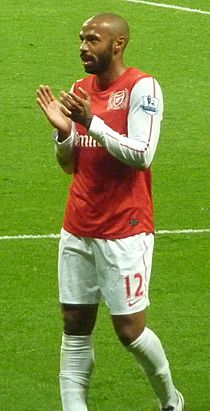
Arsenal has won 13 League Championships. This is the third highest in English football. They were the first club to reach seven and eight League Championships. As of June 2020, they are one of only seven teams to have won the Premier League since it started in 1992.
Arsenal holds the record for the most FA Cup trophies, with 14 wins. They are one of only six clubs to have won the FA Cup twice in a row (in 2002 and 2003, and again in 2014 and 2015).
Arsenal has achieved three League and FA Cup "Doubles" (in 1971, 1998, and 2002). Only Manchester United had done this before. Arsenal was also the first English team to win both the FA Cup and League Cup in the same season, in 1993. They were the first London club to reach the final of the UEFA Champions League in 2006, where they lost 2–1 to Barcelona.
Arsenal has one of the best top-flight records in history. They have finished below fourteenth place only seven times. They have won the second most top-flight league matches in English football. They also have the second most points ever in the top flight. Arsenal has been in the top flight for the most consecutive seasons (98 as of 2023–24). They also have the highest average league finishing position for the 20th century.
Arsenal holds the record for the longest unbeaten run in League matches (49 games between May 2003 and October 2004). This included all 38 matches of their title-winning 2003–04 season. In that season, Arsenal became only the second club to finish a top-flight season unbeaten. They also hold the record for the longest top-flight win streak. Arsenal set a Champions League record in 2005–06 by going ten matches without letting an opponent score. They went 995 minutes without conceding a goal.
David O'Leary holds the record for most Arsenal appearances, playing 722 first-team matches. Tony Adams is second with 669 games. The record for a goalkeeper is held by David Seaman, with 564 appearances.
Thierry Henry is the club's top goalscorer with 228 goals in all competitions. He broke Ian Wright's record in October 2005. Henry also holds the club record for goals scored in the League, with 175. Declan Rice holds the Arsenal record for the highest transfer fee paid for a player. He joined in July 2023 for an initial £100 million.
Arsenal's record home attendance is 73,707. This was for a Champions League match against Lens in 1998 at Wembley. The record attendance at Highbury was 73,295 in 1935. At Emirates Stadium, the record is 60,161, set in 2007.
Club Honours
Arsenal's first ever trophy was won as Royal Arsenal in 1890. The Kent Junior Cup was their first trophy. The first team's first trophy was the Kent Senior Cup three weeks later. Their first national senior honour was the FA Cup in 1930. The club had more success in the 1930s, winning another FA Cup and five Football League First Division titles.
Arsenal won their first league and cup double in the 1970–71 season. They repeated this in 1997–98 and 2001–02. They also won a cup double of the FA Cup and League Cup in 1992–93. The 2003–04 season was special because they went unbeaten in all 38 league matches. A special gold Premier League trophy was made for them.
| Type | Competition | Titles | Seasons |
|---|---|---|---|
| Domestic | First Division/Premier League | 13 | 1930–31, 1932–33, 1933–34, 1934–35, 1937–38, 1947–48, 1952–53, 1970–71, 1988–89, 1990–91, 1997–98, 2001–02, 2003–04 |
| FA Cup | 14 | 1929–30, 1935–36, 1949–50, 1970–71, 1978–79, 1992–93, 1997–98, 2001–02, 2002–03, 2004–05, 2013–14, 2014–15, 2016–17, 2019–20 | |
| EFL Cup | 2 | 1986–87, 1992–93 | |
| FA Community Shield | 17 | 1930, 1931, 1933, 1934, 1938, 1948, 1953, 1991, 1998, 1999, 2002, 2004, 2014, 2015, 2017, 2020, 2023 | |
| Football League Centenary Trophy | 1 | 1988 | |
| Continental | UEFA Cup Winners' Cup | 1 | 1993–94 |
| Inter-Cities Fairs Cup | 1 | 1969–70 |
- record
- s shared record
Other Trophies
When the FA Cup was the only national competition, Arsenal also played in "County Cups." These were local competitions. Arsenal's first first-team trophy was the Kent Senior Cup. Arsenal became ineligible for the London Cups when they turned professional in 1891.
Arsenal has also won many pre-season and friendly trophies. These include their own pre-season competition, the Emirates Cup, which started in 2007. During the World Wars, regular competitions were stopped. Arsenal played in wartime competitions and won several of them.
See also
 In Spanish: Arsenal Football Club para niños
In Spanish: Arsenal Football Club para niños


